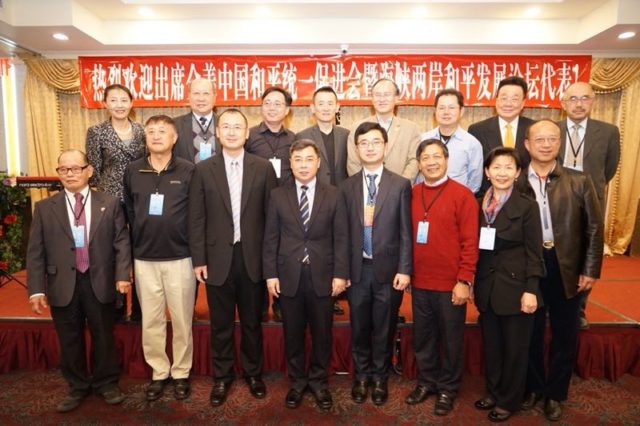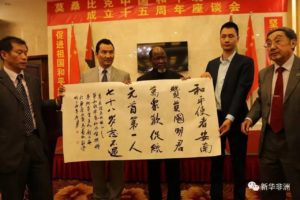
The United Front Work Department in Action Abroad: A Profile of The Council for the Promotion of the Peaceful Reunification of China
Publication: China Brief Volume: 18 Issue: 2
By:

Throughout 2017, Australia and New Zealand were roiled by controversies surrounding alleged attempts by pro-Beijing lobbying groups to influence government policies. In Australia, one of the foremost figures at the center of these controversies has been Huang Xiangmo. Huang, who first became wealthy as a property developer in the southern Chinese city of Shenzhen, built a Sydney-based real estate empire after immigrating to Australia in 2011. Investigations by Australian reporters have revealed that Huang became a major donor in Australian politics, donating nearly $2.7 million Australian dollars between 2012 and 2016 to both the Liberal and Labor Parties (Sydney Morning Herald, 2017). Huang’s role as a donor became particularly controversial after it was revealed that, in 2016, he had attempted to use a large promised donation to the Australian Labor Party to influence that party’s position regarding PRC territorial claims in the South China Sea (ABC, November 29, 2017).
In addition to his roles as a successful businessman and an influential donor behind the scenes of Australian politics, from 2014 through 2017 Mr. Huang was also the president of the Australian national branch of the Council for the Promotion of the Peaceful Reunification of China (CPPRC). Aside from Mr. Huang’s lobbying efforts of, the CPPRC has remained active in cultivating Australian politicians and public opinion in other ways, such as its October 2017 sponsorship of an event in the Tasmanian Parliament intended to promote PRC-Taiwan unification (ABC, December 4, 2017). In statements to the Australian media, Mr. Huang has described his group as “an autonomous, non-government organization” that represents the ethnic Chinese community, and denied that it maintained ties to the Chinese Communist Party (Sydney Morning Herald, 2017). The group’s website echoes this message, describing itself as a “non-government, non-profit, community-based organization” with a mission to “foster and facilitate peaceful dialogue… for the peaceful reunification of China” (Australian CPPRC Website).
The Activities of the CPPRC Abroad
Although the CPPRC has gathered greatest recent attention in Australia, chapters of the organization exist throughout the world, in countries as wide-ranging as the Philippines and Namibia (Qingnian Wang, May 1, 2017; People’s Daily Online, November 29, 2004). The group has emerged in recent years at the forefront of groups representing, or claiming to represent, ethnic Chinese communities abroad; and has also become one of the PRC’s primary institutions for organizing and mobilizing the international Chinese diaspora in support of PRC policies. The organization maintains numerous branches in the United States, including chapters in New York, San Francisco, and other major cities. The national headquarters branch in the United States is the National Association for China’s Peaceful Unification (NACPU), located in Washington, D.C. [1]
In official statements, the CPPRC takes great pains to present itself as a private organization, sharing commonalities with non-governmental organizations (NGOs) created in other countries to pursue civic-oriented causes such as environmental activism, political mobilization, and humanitarian relief. The organization also takes pains both within China and without to present itself as one that represents broad sections of Chinese society outside of the Communist Party, stressing that it involves “people from various democratic parties as well as non-party affiliated people,” and that it is a “national organization formed of volunteer members from all walks of life, with an independent legal status” (China Council for the Promotion of Peaceful Reunification, April 23, 2008).
 Members of the newly-established Mozambique chapter of the CPPRC pose for a photo at the group’s inaugural event in Maputo, Mozambique, June 18, 2017.(Photo source: Xinhua)
Members of the newly-established Mozambique chapter of the CPPRC pose for a photo at the group’s inaugural event in Maputo, Mozambique, June 18, 2017.(Photo source: Xinhua)However, such statements are misleading, and a cursory examination of the organization’s leadership structure reveals that the CPPRC is directly subordinate to the Communist Party’s United Front Work Department (UFWD). The Chairman of the CPPRC is Yu Zhengsheng, and its executive vice-chair is Sun Chunlan (CPPRC Homepage). Until their formal retirements at the 2017 CCP 19th Party Congress, these two individuals were, respectively, the member of the Standing Committee of the Politburo responsible for the United Front policy portfolio, and the director of the UFWD. This continues a long-standing practice by which these two senior-most positions in the CPPRC are occupied by the Politburo’s United Front policy czar, and the UFWD’s senior official. [2]Most clearly of all, on the UFWD’s official Chinese-language webpage (www.zytzb.gov.cn), the Council for the Promotion of the Peaceful Reunification of China is identified on a list of prominent organizations that fall within the UFWD’s “system of united front work units” (统战系统单位 / tongzhan xitong danwei). Pursuant to its role as a subordinate entity of the UFWD, the Council has acted in the past as an agent for building UFWD contacts among senior-ranking military officers in Taiwan (China Brief, October 14, 2011).The CCP United Front Work Department is an organization that plays a major role in directing Beijing’s efforts to influence public opinion and government policy in countries throughout the world (Wilson Center, September 18, 2017; Financial Times, October 25, 2017). In the past, the UFWD has generally sought to keep a low international profile, and has remained obscure to most beyond the ranks of China-watching specialists. However, the organization now appears to be adopting a more prominent profile under Xi Jinping (China Brief, December 22, 2017). This has coincided with a more aggressive effort by PRC state-affiliated entities to influence political figures and policy debates in other countries, and the efforts of the CPPRC in the United States and elsewhere closely match this pattern.
The Washington, D.C.-based chapter of the CPPRC has issued messages closely aligned with official PRC propaganda themes related to Taiwan and other issues, as seen in this statement:
Separatism in Taiwan is increasingly becoming [an] extremely unstable and dangerous factor to threaten the peace in [the] Asia-Pacific region… [We] appeal that the U.S. government and Congress should insist on our “One China” policy, on opposition against so-called “Taiwan independence,” and on… no involvement in [a] possible war across the strait caused by the provocation of separatism in Taiwan. We also call for [the U.S. Government] not to sell any weapons to Taiwan, which increases the crisis across [the] Taiwan Strait and indirectly encourages separatism (National Association for China’s Peaceful Unification [USA]).
To date, no scandals have yet come to light in the United States tying CPPRC affiliates to the sorts of bare-knuckled influence peddling revealed in the Oceania region in 2017. Thus far, the efforts of NACPU to cultivate American politicians appear to be modest, and well within the conventional bounds of what U.S. civil associations might do to influence political leaders. It has, for example, provided Congressional offices with free copies of books providing a pro-PRC slant on cross-Strait issues and sent letters opposing draft Congressional resolutions that would criticize Beijing’s crackdowns on ethnic unrest in Tibet and other areas (see: NACPU, January 28, 2008; NACPU, April 15, 2008).
Additionally, most of the online presence of NACPU and other U.S.-based CPPRC affiliates is in Mandarin, rather than English—suggesting a primary focus on molding opinion within the ethnic Chinese community—rather than an aggressive effort to influence public opinion or government policies on a broader level. It is also likely that many members of these groups see their membership primarily in the opportunistic terms of networking, and of signaling loyalty to the Chinese government—with the potential benefits that may follow—rather than as a means to effect substantive change in U.S. policy.
However, the themes in these communications, as well as those in NACPU-sponsored meetings and internet postings, closely parallel the major themes promoted by PRC spokespeople and state propaganda outlets regarding Taiwan, the South China Sea, and other contentious issues. [3] Additionally, there is ample evidence that the CPPRC is a thinly disguised front organization managed by the CCP United Front Work Department, and that it serves as a mechanism for promoting PRC state-sanctioned propaganda messages under the guise of an independent civic organization. Furthermore, the increasingly prominent role of CPPRC affiliates as self-appointed spokesmen for ethnic Chinese communities outside of China, and their role in mobilizing those communities in support of PRC policies, raises concern as to whether dissident viewpoints in those communities could be increasingly drowned out or intimidated into silence.
Conclusion
The CPPRC is only one example out of many synthetic civic groups managed by Beijing, which have long been employed by the ruling Chinese Communist Party to pose as nominally independent outlets that campaign in support of PRC policies. As the UFWD assumes an ever-more influential role in shaping the foreign policy narratives of the PRC, the Council for the Promotion of the Peaceful Reunification of China and other front organizations are likely to also assume a larger role as outlets for the propaganda themes of their parent organization. Rights to free speech and free association by U.S. citizens and legal residents should always be respected. However, those working in the fields of politics, journalism, and international affairs should remain cognizant that nominal civic groups such as the CPPRC may not be as independent as they appear on the surface, and that one need not be a government official to be a spokesperson for the Chinese Communist Party.
Notes:
- Although branches of the CPPRC outside of China sometimes use different English-language variations of the organization’s name, their Chinese-language name remains identical to that of the parent organization in China [中国和平统一促进会 / Zhongguo Heping Tongyi Cujin Hui]. For two such examples, see the home page of the Washington, D.C.-based “National Association for China’s Peaceful Reunification” (https://www.nacpu.org/aboutus.html); and the home page of the San Francisco Bay Area-based “Chinese for Peaceful Reunification – Northern California” (https://www.cpu-nc.org).
- For example, in the arrangements following the 17th CCP National Party Congress of 2007, the United Front policy portfolio in the Politburo Standing Committee was held by Jia Qinglin, who concurrently served as the chairman of the CPPRC; and Du Qinglin, the director of the CCP UFWD, also held the position of executive vice-chair of the CPPRC. See: China Brief, October 11, 2011.
- In a web posting (in Mandarin) summarizing NACPU’s January 25, 2018 annual conference in Washington, D.C., the organization uses language clearly evocative of PRC state propaganda. It states that “the goal of all federated members of the Council to Promote the Peaceful Reunification of China throughout America is to resolutely oppose ‘Taiwan Independence,’ ‘Two Chinas,’ ‘One China and One Taiwan,’ and other activities intended to split China, as well as to promote the realization of the peaceful reunification of China at the earliest date.” (National Association for China’s Peaceful Reunification, January 25, 2018).



